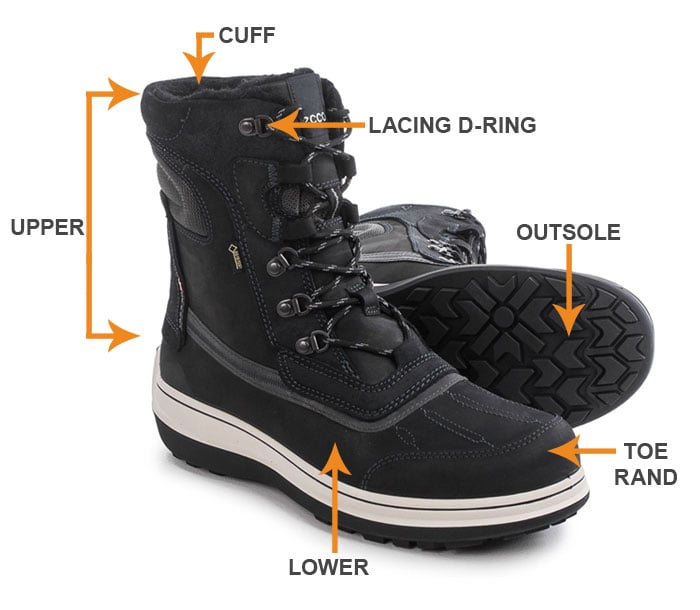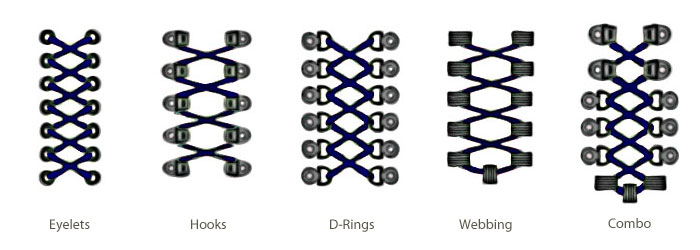
-

Pac Boots
Pac boots are generally defined as winter boots with a thick, rubber lower shell. The upper portion of most pac boots is made of leather, heavy-duty nylon or another durable material. Although the rubber shell is always waterproof, the upper may either be waterproof or water-resistant, depending on the construction. Most pac boots have a thick, insulating liner, which may or may not be removable. Pac boots are designed to keep feet comfortable in the harshest winter conditions. These boots are great for shoveling the driveway and activities like ice fishing. Boots with removable liners are convenient because the liners can be dried out much faster.
Snow Boots
Snow boots are generally any type of insulated winter boots that provide some degree of protection from the snow and cold. Unlike pac boots, most snow boots do not have a full rubber lower shell. This design makes them a little less bulky and heavy. However, snow boots typically aren’t quite as durable as pac boots and may not offer the same level of weather protection. Some snow boots have fashionable features, such as faux fur cuffs, shearling linings and other details.
Winter Hunting Boots
Generally speaking, winter hunting boots are lighter and less bulky than pac boots and snow boots. Winter hunting boots frequently include Gore-Tex® waterproof protection or a similar type of waterproof membrane. The less-bulky design is ideal for hiking over rugged terrain. However, winter hunting boots typically have less insulation compared to pac boots, and therefore aren’t quite as warm. If you plan on standing still for long periods of time in the cold (such as in a hunting blind), consider using a pair of heavy-duty pac boots for additional warmth.
Winter Work Boots
Winter work boots are similar to other winter boots, but are constructed of thick, durable leather. All winter work boots should have built-in insulation for additional warmth. Some may also have extra insulation in the footbed to protect feet from cold coming up from the ground. Select models may include a composite safety toe or steel toe. In the wintertime, only choose steel-toed work boots if absolutely necessary, as this feature tends to attract the cold. Generally, composite safety toes are better suited for cold weather conditions.
-

Winter Boot Upper
Most winter boot uppers are made from leather or heavy-duty nylon, both of which are resistant to abrasion, punctures and wind. The upper on any winter boot should extend above your ankle for optimal protection in snowy weather. To provide additional protection from snow and moisture, many winter boots include a DWR (durable water repellent) coating. For even better protection in extreme weather, look for boots with a waterproof breathable membrane, such as Gore-Tex®.
Winter Boot Lower
Heavy-duty pac boots typically have a waterproof, injection-molded rubber shell (i.e. the "cupsole"), which is welded to the upper to form the lower part of the boot. This shell's main function is to keep snow and moisture out. Boots designed for lots of walking and hiking, on the other hand, typically do not have a rubber lower shell. This creates a less bulky design with a slight reduction in weather protection (unless the boots include a waterproof breathable membrane). A rubber lower shell is great for keeping moisture out, but it also tends to trap moisture in. The best way to deal with this is to wear moisture-wicking socks made of wool, merino wool or polyester. Always avoid wearing cotton socks with winter boots.
Insulation
A winter boot’s insulation will either be built directly into the upper or included as a removable liner. Built-in insulation is typically made of synthetic fill, although some high-end winter boots may feature down insulation. The removable liners found in pac boots are usually made of felted wool, polypropylene, acrylic, Zylex® or a blend of materials. These liners sometimes come in a stated thickness, usually measured in millimeters. Some winter boots include a natural shearling (sheepskin) lining for insulation. Check out our Down vs Synthetic Guide for more information on down insulation and the various types of synthetic insulations. Some manufacturers provide temperature ratings or “comfort ratings” for their winter boots, such as "Rated to -50° F." These ratings can be used as a general guideline to determine how warm a pair of boots will be. Just keep in mind that there is no industry standard for measuring footwear temperature ratings.
Cuff
Some boots have a fleece, wool or acrylic cuff appearing above the upper, which is actually attached to the boot's liner. Some boots go even one step further and offer a pull-up gaiter with a drawstring closure to keep out snow.
Lacing Systems
There are multiple types of lacing systems. Below are a few of the most common options:
- Eyelets are simply metal-reinforced lacing holes.
- D-rings are hinged metal rings that swing free of the upper.
- Hooks are metal catches that only keep laces in place when tension is applied.
- Webbing loops (usually made of nylon) are sewn onto the upper and function similarly to D-rings.
- Combination lacing combines two or more of the above lacing systems.

Winter Boot Outsoles
The bottom of winter boots, called the outsole, should always be made of rubber or a similar material. Look for winter boots with “lugged” outsole treads to provide the best traction on slick, snowy and icy surfaces. Large, “self-cleaning” tread patterns are ideal because they're less likely to trap snow in between the treads, which can reduce traction.
-

- Choose winter boots based on the activities you’ll be doing and the weather conditions you’ll be spending time in. How a pair of boots look is much less important than choosing winter boots with the right features.
- Heavy-duty pac boots with thick insulation are best for sub-freezing conditions and short walks through deeper snow. Pac boots provide excellent weather protection but are less ideal for walking longer distances. Gaiters usually aren’t necessary when wearing pac boots.
- Lighter winter boots and insulated hiking boots are best for longer walks in cold weather and shallower snow. These boots provide moderate weather protection. For trekking in deeper snow and snowshoeing, consider using gaiters for additional protection.
- Test to see if your new winter boots have a DWR (durable water repellent) finish on the upper. If your boots have this finish, water will bead up and roll off the surface of the upper. If water doesn’t bead up, it’s a good idea to treat your boots with a DWR spray before wearing them out in the snow. Also, consider replenishing the DWR finish on your snow boots every autumn to keep them protected during the winter. Even boots with a waterproof breathable membrane should also have a DWR finish to prevent moisture from saturating the exterior fabric or leather. This will keep your waterproof footwear feeling lighter and much more breathable.